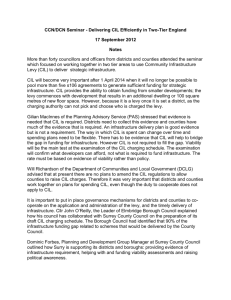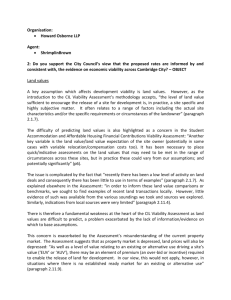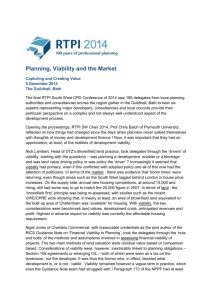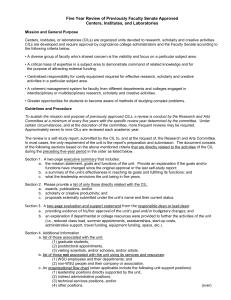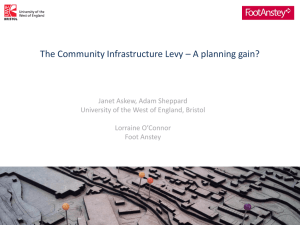Matter 1: Infrastructure needs - Engage Barnet
advertisement
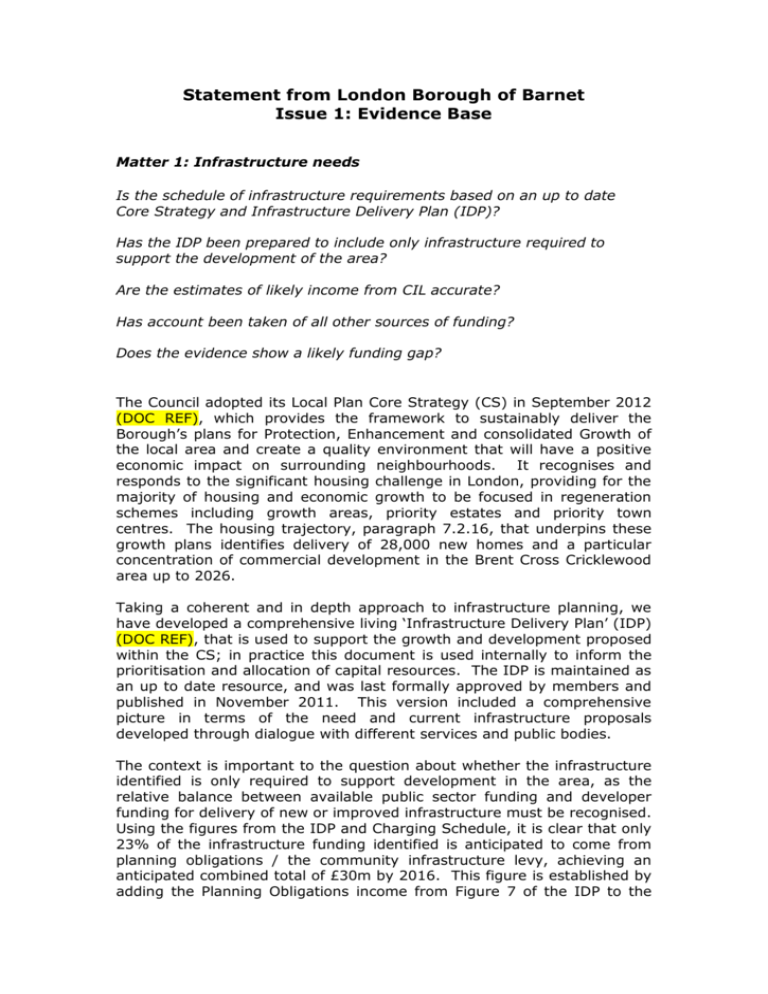
Statement from London Borough of Barnet Issue 1: Evidence Base Matter 1: Infrastructure needs Is the schedule of infrastructure requirements based on an up to date Core Strategy and Infrastructure Delivery Plan (IDP)? Has the IDP been prepared to include only infrastructure required to support the development of the area? Are the estimates of likely income from CIL accurate? Has account been taken of all other sources of funding? Does the evidence show a likely funding gap? The Council adopted its Local Plan Core Strategy (CS) in September 2012 (DOC REF), which provides the framework to sustainably deliver the Borough’s plans for Protection, Enhancement and consolidated Growth of the local area and create a quality environment that will have a positive economic impact on surrounding neighbourhoods. It recognises and responds to the significant housing challenge in London, providing for the majority of housing and economic growth to be focused in regeneration schemes including growth areas, priority estates and priority town centres. The housing trajectory, paragraph 7.2.16, that underpins these growth plans identifies delivery of 28,000 new homes and a particular concentration of commercial development in the Brent Cross Cricklewood area up to 2026. Taking a coherent and in depth approach to infrastructure planning, we have developed a comprehensive living ‘Infrastructure Delivery Plan’ (IDP) (DOC REF), that is used to support the growth and development proposed within the CS; in practice this document is used internally to inform the prioritisation and allocation of capital resources. The IDP is maintained as an up to date resource, and was last formally approved by members and published in November 2011. This version included a comprehensive picture in terms of the need and current infrastructure proposals developed through dialogue with different services and public bodies. The context is important to the question about whether the infrastructure identified is only required to support development in the area, as the relative balance between available public sector funding and developer funding for delivery of new or improved infrastructure must be recognised. Using the figures from the IDP and Charging Schedule, it is clear that only 23% of the infrastructure funding identified is anticipated to come from planning obligations / the community infrastructure levy, achieving an anticipated combined total of £30m by 2016. This figure is established by adding the Planning Obligations income from Figure 7 of the IDP to the total anticipated CIL income in the Charging Schedule (£135/sqm x the estimated floor space figure from Appendix 1). Should this estimate for income be inaccurate it is more likely to be an overestimate, as some development schemes could potentially slow down and therefore the infrastructure delivery would need to be re-profiled accordingly. The Infrastructure Delivery Plan has been prepared to address all infrastructure needs relating to population growth and development. It is impossible to separate these two matters as development could not be sustainable if the impact of natural population growth within the existing built environment is not first addressed. For this reason the Council has looked at all infrastructure required to support growth as well as all funding available to support such infrastructure. The IDP identifies all funding streams available in autumn 2011. Broadly speaking the position is unchanged since last year save for minor adjustments where income was projected. Importantly even a 5% variation to the total income would make little impact on the overall £92m Infrastructure Funding Gap. Regulation 16 requires the Council to ensure that ‘relevant evidence’ is made available for inspection and published on its website. Such evidence was made readily available during the consultation periods and has informed the Council’s preparation of its draft charging schedule. The Council’s published IDP is considered by the Council to be the most relevant and available information for meeting the requirement in Regulation 14(1a) to understand the “estimated total cost of infrastructure required to support the development of its area, taking into account other actual and expected sources of funding”. It is therefore considered that sufficient and relevant evidence has informed the identification of the infrastructure funding gap within the Borough. Matter 2: Economic viability evidence Is the CIL Viability Study (VS) based on sound data? Are the various elements, including land values, sale prices, building costs, fees and profits levels accurate and up to date? Are the assumptions in the appraisals based on realistic scenarios? The Council has sought to follow section 212(4) (b) of the Planning Act 2008 (The Act), referred to in Paragraph 6 of the Statutory Guidance on Charge Setting and Charging Schedule Procedures (The Guidance), which requires the Council to use “appropriate available evidence to inform the draft charging schedule”. The Council therefore looked to the available existing area wide Affordable Housing Viability Appraisal (VS) (DOC REF) work developed to underpin Affordable Housing policy within the CS. This document was not directly applicable in its extant format, and therefore the Council commissioned an Update Report (UVS) (DOC REF) from BNP Paribas to ensure that the existing evidence could be used appropriately in the context of developing a CIL charging schedule. The VS and UVS is considered sound because the data underpinning the assessment is appropriate to the local area, has been carefully reviewed and established using available and suitable information, is often presented within an appropriate range of confidence and final decisions have been selected through professional independent judgement, examples of this approach include: (i) Existing Use Values (EUVs) that closely reflect the value of the current use “on the range of sites that typically come forward for development in Barnet”, (VS, Paragraph 4.9). Therefore the data explicitly recognises that only land that is relatively underdeveloped or with existing low yields will come forwards for development, an average value for each land typology has then been identified (emphasised again in UVS, Paragraph 3.21). (ii) Densities have been considered within a range through which development could be delivered; average unit mixes for each density band have been selected and were informed by the Council’s housing needs survey (VS, Paragraph 4.20, 4.21). (iii) The variables inputted into the appraisals (VS, Paragraph 5.6) are all sound and reasonable judgements of the key variables. (iv) The build costs at each density are based on average data available to BNP Paribas through its banking and loan operations; these are considered reasonable figures for use in the appraisal. The Update Report considered build costs for quarter 3 of 2011 using the RICS Building Cost Information Survey Index to ensure appropriate figures were used (UVS, Paragraph 4.7 & 4.8). (v) The sales values used in the appraisals are considered highly appropriate as they are based on research and consultation by BNP Paribas with local agents on transacted property values using the base date of February 2010 (VS, Paragraph 4.17). The Update Report considered that since February 2010 house prices in Barnet had increased, returning close to 2007 market values albeit through a reduction in sales volumes, therefore the figures used in the appraisal were still highly relevant (UVS, Paragraph 2.7 & 2.8). In the judgement of BNP Paribas, the Council’s independent assessor of development viability, the input variables used within the appraisals are considered sound and appropriate. The provision of appraisal outputs in over 60 tables means that a range of realistic scenarios have been considered, and even though these cannot cover the exact issues for every development scheme, it is considered to be a sufficiently comprehensive approach that does not give undue weight to individual or specific development schemes with specific issues. The Council therefore considers that it has met the requirements of Regulation 14 (1) (b) regarding consideration for the potential effects of CIL on area wide viability. [1272 words] Issue 2: Are the charging rates informed by and consistent with the evidence Matter 3: Residential Is the charging rate soundly based on evidence of housing values across the Borough? Do the CIL charges take into account the provision of affordable housing, on all sites, of any size? Do the residential rates take into account reasonable assumptions about site specific S106 requirements? Are the arrangements for and likely impacts of S 106 requirements clear? Why does the charge not reflect the clear differences in residential viability levels across the Borough? The VS (DOC REF) and UVS (DOC REF) include housing values in terms of sales prices per square metre from Land Registry data (UVS, Paragraph 2.8) as a core component of the viability appraisal process and research by Savills (UVS, Paragraph 2.10) in order to project future changes in house prices. From this information it was possible to identify the broad categories of sales values that could appropriately be applied, and these are used in the viability appraisal tables. The Council’s UVS indicates that were the Council to consider differential rates, it could introduce three maximum CIL rates for residential development of £210, £250 or £350 per sqm, dependent on the location in the borough (UVS, Paragraph 7.5). In deciding to set a single rate of CIL lower than these maximum rates that could be charged, the Council took a view that confidence and certainty for developers was required in the short term given the broader economic challenges for new development. An upward trend in the development market is not certain, and therefore a simple and straightforward CIL rate that is broadly comparable to or less than existing s.106 tariffs was required to be introduced in order to reassure developers and bring confidence to the development community through the transition to CIL. So despite the possibility of differential rates being introduced to potentially secure additional CIL income, it was felt that a more reasonable approach was to focus on a simple, single and broadly comparable rate, provided that the Council reviews the CIL rates in the near future to account for the potential for increases to viability in the residential development market; three years from adoption, in 2016, was deemed a suitable period for supporting this transition process. Furthermore, the requirement for the Council to revise its affordable housing target from 30% up to 40% as agreed within the Core Strategy Examination Process in December 2011/January 2012 could have meant that any CIL rate proposed close to maximum viable thresholds would have then affected the viability of development across the Borough, necessarily requiring a process of reappraisal of the proposed CIL rate/s. However as a result of the Council’s decision to select a £135 single flat rate of CIL, despite the policy change, together the introduction of CIL and a 40% affordable housing target will not impact on the viability of residential development. In calculating the residual values, BNP Paribas incorporated the following assumptions (UVS, Paragraph 6.5): (i) a residual level of Planning Obligations of £20/sqm, (ii) minimum open space standards and requirements, (iii) Mayoral CIL of £35 /sqm. It is therefore considered that the rate introduced makes full allowance for the impact of other policy considerations that impose a cost upon development outside of the direct considerations within the viability appraisal process itself. Certainly the £20/sqm planning obligation allowance should be sufficient to address the requirements of minor developments and small major developments. The Council recognises the importance of reviewing planning obligations policies alongside the introduction of a CIL rate to ensure that a suitable balance can be struck that does not affect development viability across the area or in terms of a specific form or scale. The Council has therefore published for public consultation its draft ‘Planning Obligations Supplementary Planning Document’ (SPD) (DOC REF) to provide clarity and guidance on the totality of obligations that will be considered in relation to new development, as well as to ensure that there is a clear and sound process for negotiating Planning Obligations and considering how these can appropriately sit alongside CIL payments and expenditure. The draft Planning Obligations SPD recognises three forms of planning obligation: ‘Prescribe’, ‘Mitigate’ and ‘Compensate’ (SPD, Paragraph 2.3.3). The introduction of CIL has been defined (SPD, Paragraph 2.3.4) to replace the need to set planning obligation tariffs for off site contributions to mitigate for the impacts on strategic infrastructure. The relationship between Planning Obligations and CIL is therefore a particular concern in relation to Regeneration Areas and other places where ‘on site’ planning obligations are required to make development acceptable. Such requirements could not be accounted for within an area-wide approach to viability appraisal; therefore through exceptional circumstances relief or considering expenditure of CIL options (SPD, figure 1, page 13) the Council is seeking to provide mechanisms to address the risk of ‘double charging’ created when setting a CIL rate upon these development areas. The interaction of the CIL Charging Schedule with Planning Obligations policy was a particularly important matter for the Brent Cross Cricklewood development partners, which alongside some specific concerns regarding the wording used in the Draft Charging Schedule, was sufficient cause for concern to require a formal objection to the Charging Schedule proposals. However, through speeding up the timetable for finalising and commencing public consultation on the revised Planning Obligations document, alongside agreement to the additional corrections which were submitted by the BXC partners (DOC REF); the Council has been able to agree a Statement of Common Ground (DOC REF) with the development partners that ensures such concerns can suitably be addressed through the proposed processes for negotiation of planning obligations. Matter 4: Retail development Are the assumptions in the retail viability scenarios of the VS robust and consistent with the evidence? Why has the council not proposed a lower retail rate in those parts of the Borough where retail viability is less secure? Is the rate justified in general terms? The assumptions used in the retail viability scenarios (UVS, Paragraph 4.6 to 4.10) are considered robust because they were developed by BNP Paribas – the Council’s independent assessor of area-wide development viability, within which they have adopted an appropriate figure for the capitalisation of yields, used standardised figures for build costs linked to the RICS Building Cost Information Survey Index, letting fees, professional fees, appropriate financing costs, a developer profit of 20%, recognition that new build achieves a higher rent than existing floor space and a 15% premium on existing uses in order to bring forward land. In practice this land premium is often not required as new retail is usually brought forward in relation to reinforcing the market share of existing retail development through increasing appeal and introducing a retail mix. The sales rates included are based on actual lettings data over a two year period showing the retail yields available by postcode (UVS, Paragraph 4.3 and Table 4.4.1). The particular value of how this information is presented is that it demonstrates the wide range of rents achieved in some areas, indicating that the size and quality of floor space, or specific location benefits, will influence the likelihood of development in such areas being viable inclusive of a CIL contribution. As set out (UVS, Paragraph 4.2) commercial schemes will not come forwards unless they deliver additional value through intensification or increased yields. Only schemes in each area where viable yields can be achieved are likely to come forwards for development. This means that despite some areas ‘on average’ being considered unviable, in reality there is a mixed local background picture that underpins that perspective. Areas with a particularly significant range of retail rents included: i. HA8 (Edgware and Burnt Oak): ii. N11 (Friern Barnet), iii. N12 (Woodside Park and North Finchley), iv. NW7 (Mill Hill and Mill Hill East). £15 (unviable) - £30 (CIL = £524), £8.5 (unviable) - £33 (CIL > £524) £13 (unviable) - £47 (CIL > £925) £28 (CIL > £136) - £44 (CIL > £925) The above information is relevant when considering representations submitted in relation to the decision not to adopt differential rates of CIL for retail development by area, despite the adoption of differential rates being possible according to the evidence base. The reality, as shown above, is that there will be some development within each postcode that could be written off as unviable in any event, and some developments that would be viable even with higher CIL charges. Specifically addressing the concerns of the Edgware Broadwalk Centre team, presented to the Council through pre application sessions after the close of the Draft Charging Schedule consultation, the range of viability within the HA8 postcode sector would lend itself to the view that the Major Town Centre of Edgware is likely to demand medium to higher levels of rent, with smaller retail parades and the lower value Burnt Oak District Centre likely to account for the lower and unviable rents listed within the range. Furthermore, the specific issue with regards to development around the Broadwalk Centre Site is linked to the requirement to pay CIL on any new multi-storey car park without the possibility of offsetting the floor space against the existing surface car parking. Unfortunately this is a problem relating to the CIL regulations. Therefore in isolation it is not a strong reason for arguing against setting a single CIL rate across the area. In general terms therefore the decision to introduce a £135 single flat rate of CIL, rather than a complex mixture of rates by area and use class, is considered to best meet the test set out in Regulation 14. The Council has aimed to strike an appropriate balance between the desirability of seeking to fund the estimated total cost of infrastructure required to support the development of the area and the potential effect of the imposition of CIL on the economic viability of development across the area. In so doing it has decided that a single lower flat rate for the area is the most appropriate approach to both support infrastructure delivery and delivery of local development in the short-medium term. Matter 5: Office, industrial, warehouse and other employment development The viability shows that none of these developments would be viable if CIL is charged; is there any other evidence that the charge will not deter development across a wide range of employment uses? The Charging Schedule identifies the historic pattern of commercial floor space being delivered in Barnet over the past 7 years since the Annual Monitoring Report (AMR) was introduced. This demonstrates a history of very little new office and industrial floor space being delivered, and in almost all cases through (i) mixed use developments, (ii) replacement for existing commercial floor space, or (iii) the introduction of mezzanine retail floors that wouldn’t be CIL liable under the regulations. This historic pattern underscores the view taken in the UVS that new office and industrial development was unlikely to come forward in the near future. Moreover the Council is increasingly seeing applications for conversion of existing office floor space to residential / hotel uses and redevelopment of industrial sites as new mixed use schemes because these will secure greater overall yields for the landowner. Such developments ideally involve some level of re-provision of A2 or B1 office floor space, particularly when located in town centres, but in most cases they rarely involve the creation of additional floor space, so are not liable to pay CIL. Matter 6: Other development Does the evidence demonstrate that the majority of development (other than residential and retail) would not be viable if a levy was charged? What evidence is there that community development will be viable, even if an exceptions policy (which includes legal requirements for Section 106 contributions at least equivalent to the CIL charge) is implemented? The Council has looked into the types of ‘other’ floor space that are likely to be developed in the near future that will deliver over 100 sqm of net additional floor space, and these essentially fall into four categories: i. Large leisure uses delivered as part of a mixed use scheme (e.g. multiplex cinemas built in shopping centre developments) - any minor viability issue linked to the single rate could be addressed through the mixture of uses brought forwards. ii. Large educational, community facilities or places of worship – most likely these will be brought forwards by registered charities, and therefore would be eligible for Charitable Relief. iii. New schools, extra care facilities or other large community facilities delivered by Barnet Council or on behalf of Barnet Council in order to address a strategic need. Where these are not undertaken as a change of use application or <100sqm expansion to existing floor space, then the Council can incorporate the project into its IDP and apply an appropriate CIL contribution towards the cost of delivering the project. iv. Health facilities and facilities related to other public sector partners such as the Metropolitan Police and London Fire and Emergency Planning Authority. Again where such projects are identified as meeting a necessary or critical infrastructure need, then there is no reason why any project would not be deemed eligible for a CIL contribution. The majority of community uses to be delivered that will fall within the broad umbrella of ‘other’ uses will be grant funded in some way or other, and therefore the introduction of a CIL charge would add an additional cost to delivering that development. The identification of the step of considering either the use of exceptional circumstances relief or reviewing CIL expenditure plans within the SPD (SPD, Figure 1, Page 13) provides a means of addressing these problems when they occasionally arise. In parallel, the less viable commercial uses such as leisure facilities and specific forms of residential development delivering particular community needs will be able to benefit from (i) the use of exceptional circumstances relief where very large schemes include such beneficial uses or (ii) cross subsidy through mixed use development or alternatively (iii) the expenditure or allocation of CIL income where this would be compliant with legislation. The IDP provides a tool for capturing where such ‘other’ uses are of particular necessity in relation to the Council’s growth plans. Ongoing changes are made to the IDP as required to reflect the changing needs of growth and development in the borough or strategies of service providers; this takes place as and when dialogue with public services / infrastructure providers identifies the need for revision. No provider of public infrastructure, including the Metropolitan Police and London Fire and Emergency Planning Authority, should be concerned about potential future projects currently being left out of the IDP, because these can be added as the organisational infrastructure plans develop. The Council has made a commitment through Paragraph 3.8.2 and 3.8.3 of the Charging Schedule to ensure appropriate CIL expenditure is made available to infrastructure projects that have become CIL liable through the introduction of the single CIL rate yet deliver wider community benefit. In terms of ‘other’ uses the decision to introduce a £135 single flat rate of CIL is recognised to deliver specific viability challenges, but rather than having a complex mixture of rates by area and use class a single rate is considered to best meet the test set out in Regulation 14. The Council has aimed to strike an appropriate balance in relation to the potential effect of the imposition of CIL on the economic viability of development, but in so doing it has decided that there is insufficient ‘other’ development planned to justify not setting a single flat rate and therefore delivery of local development can be assured in the short-medium term. [2604 words] Issue 3 – Will the rates put the overall development of the area at risk? Is the rate a reasonable proportion of development costs? What will be the effect on affordable housing provision? Will the rates prove to be a drag on housing, retail and employment growth? What will be the effect on the provision of community facilities? Has an appropriate balance between helping to fund new infrastructure and the potential effects on economic viability been achieved? The CIL rate proposed by Barnet is a very reasonable level of the build costs accounted for within the Viability Appraisals, less than the premium landowners will take for making land available to develop and far less than the level of profit a developer requires. Specifically, using the range of build cost /sqm figures listed in the viability appraisals: £1022 £2010/sqm (UVS, Paragraph 5.9), the rate of CIL levied upon residential development is equivalent to 7 - 13% of build costs, making it broadly equivalent to the marketing / letting fees applied to a development. Office and retail rates for build costs used in the viability appraisals are £1305/sqm and £901/sqm respectively (UVS, Paragraph 4.7), meaning that CIL equates to 10-15% of commercial floor space build costs. In all cases the rate of CIL is less than the 15% landowners’ premium built into the Existing Use Values within the viability appraisals to enable land to come forwards for development, and far less than the 20% developer profit on cost included within the residual valuation calculations. The development land supply identified by the Council comprises of mainly two types of existing land uses brought forwards for redevelopment (UVS, Paragraph 6.7). The major development sites either secure the level of density upon an existing residential / commercial site or involve change of use of a site from industrial / community uses in order to deliver development. Such changes are identified through the viability appraisals to be highly viable at the sales rates achievable across the Borough, even with the added cost of affordable housing requirements. The other kind of highly viable development relates to minor development sites where either there is conversion of existing buildings, so called ‘garden grabbing’ or simply an increase in density through replacement of single dwellings with a block of flats, all of which are not subject to affordable housing requirements due to the scale of development. Therefore the combined impact of CIL and affordable housing requirements will not make development unviable. With 95% of Barnet’s anticipated development pipeline to 2016 being residential development (Charging Schedule, Appendix 1), it was felt that immediately after a major recession it would be too great a risk to local employment, economic growth and housing delivery to introduce a CIL rate that would increase the overall charge upon development beyond existing s.106 requirements, as this could further act to dry up the supply of land coming forwards for development. To avoid landowners / developers land banking until sales values raise again, the Council determined not to push development viability at this time. Sensitivity analysis was undertaken (UVS, Paragraph 4.1.4) and this identified that a 25% increase in the CIL rate would only increase income by £3.2m, whilst significantly increasing the risk of sites coming forwards. This approach in actuality may lead to at least the same level of CIL income or more than if sites did not come forwards during the period and no CIL was paid at all. The effect of CIL on the viability of community facilities was explored fully in Matter 6; this recognised that although the VS explores the opportunity for differential rates to be set, with a community uses (D1) rate of zero, the negative impacts of a £135 /sqm flat rate can be addressed to ensure that critical and necessary community infrastructure can still be provided. Only in the regeneration areas is it possible to foresee community facilities that might be brought forward by a developer as part of a package of requirements that would mean it is no eligible for relief, in these circumstances the use of exceptional relief or the ability for the Council to agree to apply CIL income towards delivery of specific facilities can be agreed up front in the Planning or developer agreements in order to provide the required level of certainty for the developer. At present the Council has therefore received no example of a community facility that will be made unviable by the approach being taken by the Council. In the opinion of the Council, the decision to apply a rate of £135 /sqm upon all eligible development within the borough meets all the tests set out in Regulation 14. The rate is considered to strike an appropriate balance between the cost of funding infrastructure and the potential impact of CIL on the viability of development across the Borough. The anticipated annual administrative costs have been made clear in the Charging Schedule and these costs can be accommodated within the monitoring percentage outlined. Furthermore contrary to the assertion in the consultation response from UBS (Savills) (DOC REF), the Council has ensured that its VS fully accounts for the Mayoral CIL within the residual valuation calculations and the rate included is £35 /sqm (UVS, Paragraph 7.4), as adopted in the Mayoral Charging Schedule in February/March 2012 (DOC REF). [878 words]
